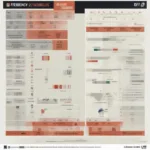The Chameleon game is a social deduction party game that’s all about blending in and spotting the odd one out. It’s a test of your powers of observation, deduction, and quick thinking. This guide will walk you through everything you need to know about how to play Chameleon, from setting up the game to advanced strategies for both the Chameleon and the other players.
Understanding the Basics of Chameleon
The Chameleon game revolves around a secret word known to all players except one – the Chameleon. The Chameleon’s objective is to blend in and avoid being discovered, while the other players try to identify the Chameleon. Each round involves selecting a topic card and a secret word associated with it. Everyone then takes turns giving one-word clues related to the secret word, without revealing it directly.
Setting Up the Game
Setting up Chameleon is straightforward. Shuffle the topic cards and deal one face down to each player. Then, place the code card in the center of the table. One player spins the spinner to determine a color on the code card. The letter and number combination corresponding to the spun color reveals the secret word on each player’s topic card. Only the player whose card matches the spun color knows the word; they are the Chameleon.
Playing a Round of Chameleon
Once the secret word is established, each player (including the Chameleon) takes turns saying a single word related to the secret word. The Chameleon must try to blend in by giving a clue that sounds plausible, while the other players try to deduce the secret word based on the clues given. The challenge lies in choosing words that are relevant but not too obvious, especially for the Chameleon.
Identifying the Chameleon: Tips and Strategies
Identifying the Chameleon requires careful observation and deduction. Pay attention to the order of clues given, as the Chameleon may struggle to come up with convincing words later in the round. Look for clues that seem out of place or don’t quite fit with the established theme. Discrepancies in word choice can often be a telltale sign. Don’t hesitate to ask clarifying questions during the discussion phase.
Strategies for the Chameleon
Being the Chameleon requires quick thinking and adaptability. Try to pick up on the overall theme that other players are establishing and give clues that fit within that framework. Don’t be afraid to take risks with your clues, but avoid being too obscure or unrelated. If you’re unsure of the secret word, try to steer the conversation towards a related topic where you feel more comfortable.
Advanced Strategies and Tips
As you become more familiar with the game, you can employ more advanced strategies. Pay attention to body language and facial expressions. Sometimes, a player’s hesitation or a subtle change in demeanor can give away their identity. For the Chameleon, mirroring the language and tone of other players can be an effective way to blend in.
Variations and House Rules
While the basic rules are consistent, there are variations and house rules you can implement to add more complexity and fun to the game. For example, you can introduce time limits for giving clues, or allow players to pass their turn if they’re unsure. Some players also enjoy adding a “double agent” role, where another player secretly knows the Chameleon’s identity.
 Advanced Strategies and Variations for Chameleon Game
Advanced Strategies and Variations for Chameleon Game
Playing Chameleon with Different Group Sizes
Chameleon is adaptable to various group sizes. With smaller groups, the game becomes more intimate and focused on individual deductions. Larger groups can make it easier for the Chameleon to blend in, but also provide more opportunities for observant players to spot inconsistencies.
Why Play Chameleon?
Chameleon is a fun and engaging game that encourages social interaction and critical thinking. It’s a great icebreaker for parties and gatherings, and it’s easy to learn, making it accessible to players of all ages. The fast-paced nature of the game keeps everyone on their toes, and the element of deception adds a thrilling layer of excitement.
Conclusion: Mastering the Art of Deception
Playing Chameleon is all about mastering the art of deception and deduction. Whether you’re the Chameleon blending in or a detective trying to uncover the hidden identity, the game offers a unique and engaging experience. So gather your friends, sharpen your wits, and get ready for a game of Chameleon!
FAQ
-
How many players can play Chameleon? Chameleon is designed for 3-16 players.
-
How long does a game of Chameleon typically last? A game of Chameleon can last anywhere from 15 to 30 minutes, depending on the number of players and the complexity of the rounds.
-
Is Chameleon suitable for children? Yes, Chameleon is suitable for children aged 8 and up. The simple rules make it easy for kids to grasp, while the social deduction aspect can help develop their critical thinking skills.
-
What makes a good clue in Chameleon? A good clue is relevant to the secret word without being too obvious. It should fit within the overall theme established by other players’ clues.
-
Can I play Chameleon online? While Chameleon is primarily a tabletop game, there are online platforms and apps that offer similar social deduction experiences.
-
What if two players choose the same one-word clue? This can happen and actually adds another layer of intrigue to the game! It could mean both players are on the right track, or it could be a clever tactic by the Chameleon to further disguise themselves.
-
What makes Chameleon different from other social deduction games? Chameleon focuses on word association and subtle cues, rather than complex roles and abilities. This makes it accessible to a wider audience and creates a unique gameplay dynamic.

